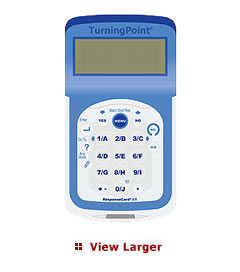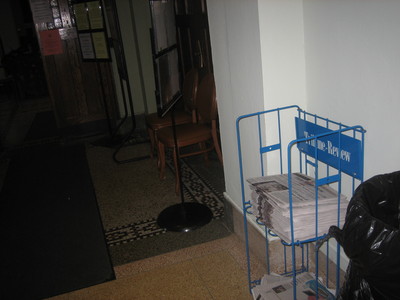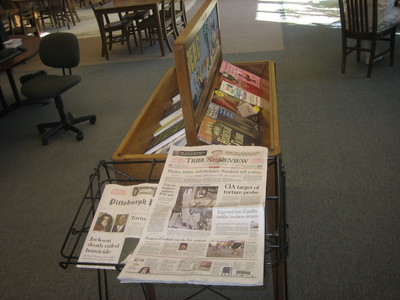August 2009 Archives
Assigned Text:
Byron, TV News: What Local Stations Don't Want You to Know
Everyone will read and be prepared to talk about these two sections of an essay by award-winning broadcast journalist Greg Byron.
We will divide the class up into groups that will be ready to discuss the following sections:
- Local
TV news is completely ratings driven.
You'll learn the secrets of how they have redefined what news is--and it isn't news anymore! - Anchors
are performers--not journalists.
We are being told they are something they really are not. You'll find out what they are.
We will divide the class up into groups that will be ready to discuss the following sections:
- Local stations don't cover your community-- they won't spend the money to do it. They're filling time between commercials.
- Image nearly always overtakes substance--so if you're looking for facts, you'll be disappointed. You'll learn how they play your emotions.
- TV won't cover many stories--there's an unholy alliance between the news people, their sources, and their advertisers.
- What You can do to fix TV News --tips on making your views known, plus some free advice for broadcasters
Continue reading Byron, TV News: What Local Stations Don't Want You to Know.
Assigned Text:
Onion, Something Is Happening in Haiti
Topic:
Media Critique
Key Concept:
Newsworthy vs. Snoozeworthy
"Dog bites man" is snoozeworthy because it happens all the time, but "man bites dog" is less common, so it is more newsworthy.
A Newsworthy Story
- is uncommon (rather than common)
- affects many people (rather than few) people
- has significant impact (rather than trivial)
- happens nearby (rather than far away)
- involves prominent people (rather than ordinary people)
Continue reading Newsworthy vs. Snoozeworthy.
Assigned Text:
A Famous Person Has Died
A comic strip called "Goodbye, Foom" on a site called "Pictures for Sad Children" offers commentary on the role of television in the creation of public events.
Don't be scared by the word "quiz" -- this is just to test the "clicker" hand-held voting gadgets. (Bring the gadgets every day… I won't announce every clicker assessment session.)
Assigned Text:
Broadcast Journalism
On Thursday, watch WTAE-TV "Channel 4 Action News" at 5, 6, or 11pm.
Keep a log of how the show uses its time. (Theme music? Anchors chatting? Promotion of stories that are "coming up after the break"?)
Keep a log of how the show uses its time. (Theme music? Anchors chatting? Promotion of stories that are "coming up after the break"?)
- During a 30 minute TV news program, how much time is spent on actual news?
- Of that actual news content, how much was created by the WTAE reporters here in the Pittsburgh area?
- What is happening during the rest of the time?
- Compare this WTAE job description with the characteristics of a "journalist" from The News Manual.
Continue reading Broadcast Journalism.
Assigned Text:
Clark & Scanlon 287-294
The building blocks of journalism. Use Tuesday's Tribune-Review to find specific examples of two or three general points that Scanlon mentioned.
Key Concept:
Spike (v.)
To spike a story is to reject it for publication. Perhaps the story is not newsworthy, important facts cannot be confirmed, or the reporter seems too close to the story to be objective. The editor would traditionally stick the pages onto a metal spike on his desk.
Key Concept:
Hard News
Hard news describes stories that are newsworthy chiefly because they are about events that have a significant impact on the lives of many people. Examples might include an outbreak of an infectious disease, the bursting of a downtown water main, a hostage crisis at a local daycare, or an attempted assassination of a dignitary visiting the White House. Global events, such as wars and crises, are hard news.
The story about the lonely zebra in another state that escapes from the zoo and is recaptured when it takes an interest in a police officer's horse? Definitely soft news, unless, for instance the chase for the zebra causes a traffic snarl that leads to a violent road rage incident. (See "If it bleeds, it leads.")
The story about the lonely zebra in another state that escapes from the zoo and is recaptured when it takes an interest in a police officer's horse? Definitely soft news, unless, for instance the chase for the zebra causes a traffic snarl that leads to a violent road rage incident. (See "If it bleeds, it leads.")
Continue reading Hard News.
Key Concept:
Lead (sometimes lede)
One or two sentences at the beginning of a news story that encapsulate the news. Write it so that the reader would still understand the main point of the story even if he or she only read the lead.
Continue reading Lead (sometimes lede).
A creative expression of your relationship to the news. Have you ever "made the news" -- as a subject or as a reporter? How do we, as consumers, "make the news" that is offered to us?
Continue reading Preview Ex 1.
Assigned Text:
Print Journalism: Tribune-Review
Read (and bring to class) a copy of Tuesday's Tribune-Review. Copies are usually available for free outside the cafeteria, and there is a copy for you to consult in Reeves Library.
In class, we will be focusing on the newspaper as a physical object, and specifically on the layout of the front page.
In class, we will be focusing on the newspaper as a physical object, and specifically on the layout of the front page.
- What is the function of the various parts of the front page?
- How do those parts work together to communicate the relative importance of the news items?
- How does the front page differ from the Tribune-Review home page?
Topic:
Print Journalism
 A response card, nicknamed a "clicker," is a hand-held voting gadget.
I'll be using them as a quick way to assess your mastery of course
material, so they are not optional.
A response card, nicknamed a "clicker," is a hand-held voting gadget.
I'll be using them as a quick way to assess your mastery of course
material, so they are not optional.It's my understanding that, over the summer, the bookstore was initially expected to handle the ordering process for those students who asked them to do so in advance, but apparently students found out it was much cheaper to order the devices themselves.
The ordering instructions are available on GriffinGate. The link below should take you directly to a PDF that explains all the details. (Note that option 1, order from the bookstore, is the one that students say is not viable anymore. So you'll need to try option 2.)
2009 Ordering Instructions for XRC-01 ResponseCard XR
If that link doesn't work, log in to GriffinGate, and look for the box "GriffinGate Home" on the left side. In that box, click on "GriffinGate Help Guides - Downloadable Resources". The ordering instructions are in the "GriffinGate Step-By-Step Guides" section.
Several students have asked me whether they can purchase other models, or whether they can purchase used models. I honestly do not have the answer, and since this is the first semester SHU is using these cards, if you do buy a used model, please double-check that there's a return policy.
News:
Today's Tribune-Review
Topic:
Weblog Preview
Part 1: What's a weblog? How do I set one up at SHU?
(9 minutes)
Part 2: How do I use my blog for class? (7 minutes)
Part 2: How do I use my blog for class? (7 minutes)
According to The News Manual (an introductory text intended for readers in developing nations):
There are many reason for becoming a journalist and many type of journalists to become. It is a career with many challenges and rewards.
Journalists must:
- Have an interest in the world around them.
- Love language.
- Have an alert and ordered mind.
- Be able to approach and question people.
- Be polite but persistent.
- Be friendly and reliable.
Continue reading Journalist.
Topic:
News
We will try to construct our own definition in class.
Topic:
Course Overview
Welcome to EL 227, "News Writing."
The course website is located at http://jerz.setonhill.edu/EL227. I will update the online syllabus periodically, adding chapters in our textbooks or links to reporting on current events, as our progress in the course dictates. The printout I give on the first day of classes is only part of the information available online.
- Introductions
- What is news?
- What is a journalist?
- Online syllabus and blogging overview.
- What's due for Wednesday, Aug 26?
- Time permitting: the CRAFT of journalism.
Continue reading Course Overview.


Recent Comments
Andrew Wichrowski on Haiman 71-73: http://blogs.setonhill.edu/And
Andrew Wichrowski on Haiman 57-67: http://blogs.setonhill.edu/And
Andrew Wichrowski on Cavalier Daily: http://blogs.setonhill.edu/And
Andrew Wichrowski on Harvard Crimson: http://blogs.setonhill.edu/And
Jessie Krehlik on Portfolio 4: http://blogs.setonhill.edu/Jes
April Minerd on Portfolio 4: http://blogs.setonhill.edu/Apr
Dianna Griffin on Haiman 57-67: http://blogs.setonhill.edu/Dia
Dianna Griffin on Portfolio 4: Done :) http://blogs.setonhill
Dianna Griffin on Haiman 71-73: http://blogs.setonhill.edu/Dia